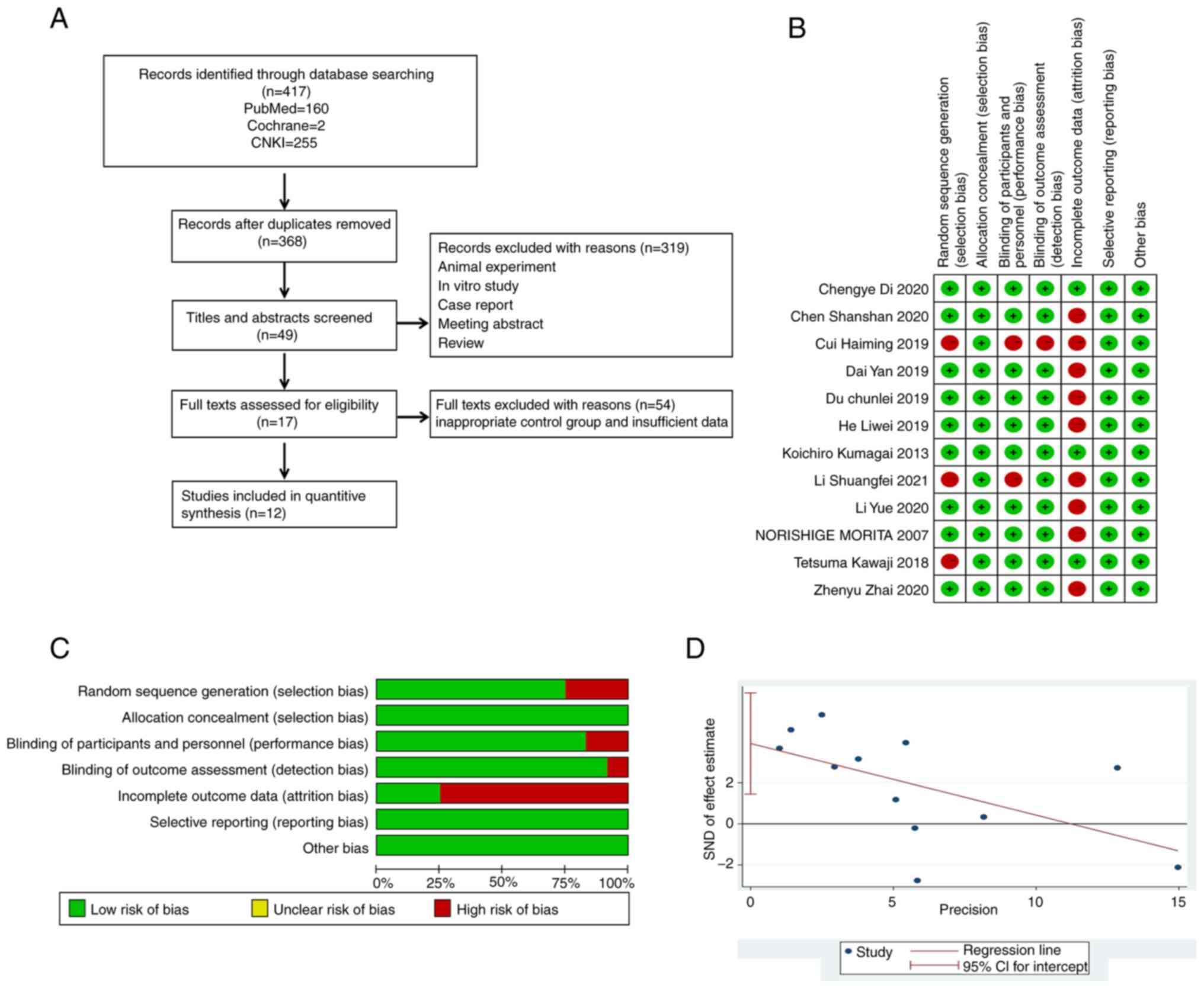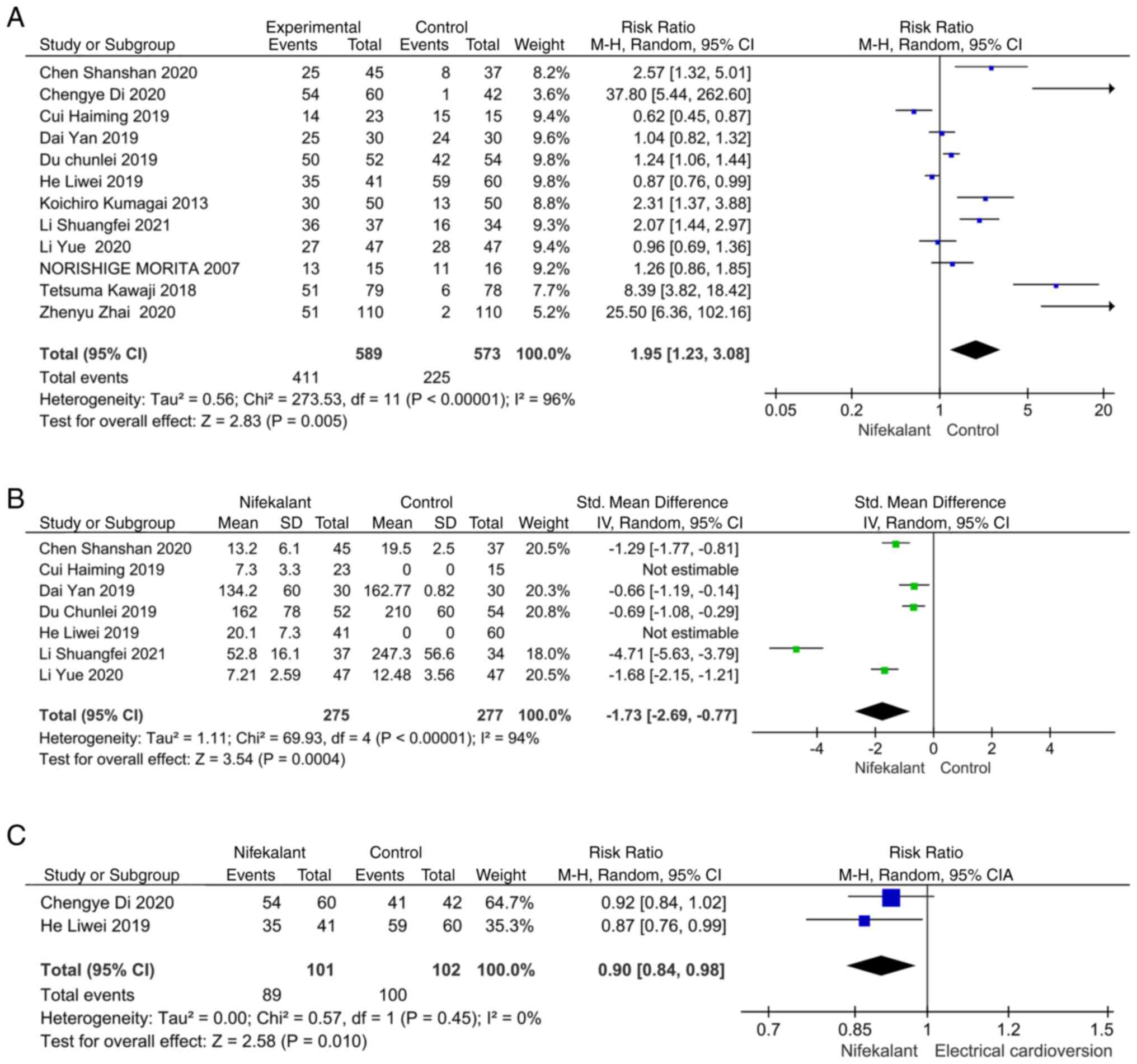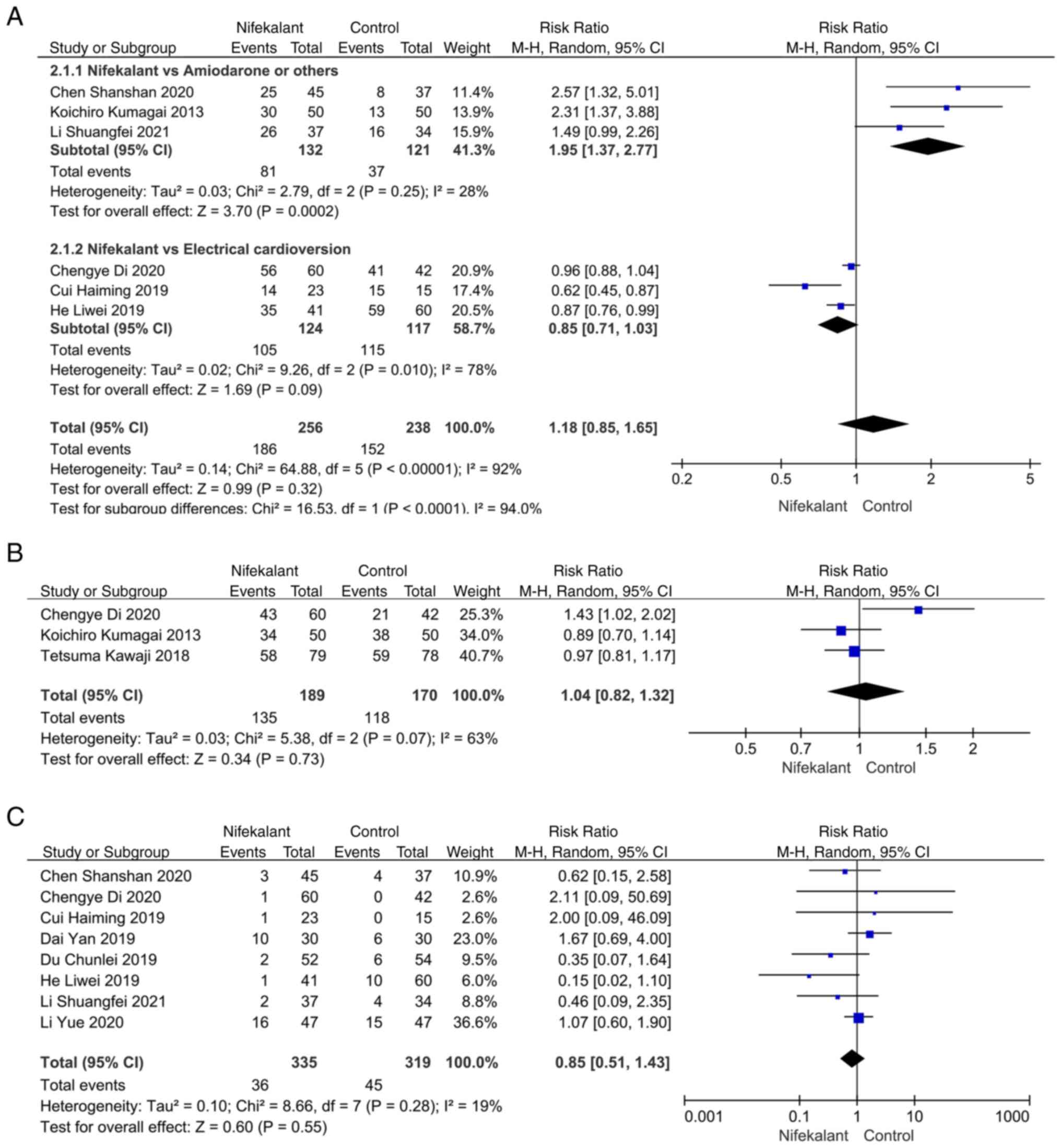|
1
|
No authors listed. Atrial fibrillation.
Nat Rev Dis Primers. 8(20)2022.PubMed/NCBI View Article : Google Scholar
|
|
2
|
Baman JR and Passman RS: Atrial
fibrillation. JAMA. 325(2218)2021.PubMed/NCBI View Article : Google Scholar
|
|
3
|
John RM, Michaud GF and Stevenson WG:
Atrial fibrillation hospitalization, mortality, and therapy. Eur
Heart J. 39:3958–3960. 2018.PubMed/NCBI View Article : Google Scholar
|
|
4
|
Yandrapalli S, Malik AH, Namrata F,
Pemmasani G, Bandyopadhyay D, Vallabhajosyula S, Aronow WS,
Frishman WH, Jain D, Cooper HA and Panza JA: Influence of diabetes
mellitus interactions with cardiovascular risk factors on
post-myocardial infarction heart failure hospitalizations. Int J
Cardiol. 348:140–146. 2022.PubMed/NCBI View Article : Google Scholar
|
|
5
|
Sepehri Shamloo A, Dagres N and Hindricks
G: 2020 ESC guidelines on atrial fibrillation: Summary of the most
relevant recommendations and innovations. Herz. 46:28–37.
2021.PubMed/NCBI View Article : Google Scholar : (In German).
|
|
6
|
Kuck KH, Lebedev DS, Mikhaylov EN, Romanov
A, Gellér L, Kalējs O, Neumann T, Davtyan K, On YK, Popov S, et al:
Catheter ablation or medical therapy to delay progression of atrial
fibrillation: The randomized controlled atrial fibrillation
progression trial (ATTEST). Europace. 23:362–369. 2021.PubMed/NCBI View Article : Google Scholar
|
|
7
|
Li Z, Liu Q, Liu F, Hidru TH, Yang Y, Wang
S, Bai L, Chen J, Yang X and Xia Y: Atrial cardiomyopathy markers
and new-onset atrial fibrillation risk in patients with acute
myocardial infarction. Eur J Intern Med. 102:72–79. 2022.PubMed/NCBI View Article : Google Scholar
|
|
8
|
Savelieva I, Graydon R and Camm AJ:
Pharmacological cardioversion of atrial fibrillation with
vernakalant: Evidence in support of the ESC guidelines. Europace.
16:162–173. 2014.PubMed/NCBI View Article : Google Scholar
|
|
9
|
Lévy S: Cardioversion of recent-onset
atrial fibrillation using intravenous antiarrhythmics: A European
perspective. J Cardiovasc Electrophysiol. 32:3259–3269.
2021.PubMed/NCBI View Article : Google Scholar
|
|
10
|
Kawaji T, Shizuta S, Yamagami S, Aizawa T,
Komasa A, Yoshizawa T, Kato M, Yokomatsu T, Miki S, Ono K and
Kimura T: Clinical utility of intravenous nifekalant injection
during radiofrequency catheter ablation for persistent atrial
fibrillation. J Atr Fibrillation. 11(1839)2018.PubMed/NCBI View Article : Google Scholar
|
|
11
|
Harayama N, Nihei SI, Nagata K, Aibara K,
Kamochi M and Sata T: Drug therapy for shock-resistant ventricular
fibrillation: Comparison of nifekalant and amiodarone. J UOEH.
38:35–46. 2016.PubMed/NCBI View Article : Google Scholar : (In Japanese).
|
|
12
|
Kofune T, Watanabe I, Okubo K, Okumura Y,
Masaki R, Shindo A and Saito S: Effect of IKr blocker nifekalant on
atrial action potential duration after successful internal
cardioversion of chronic atrial fibrillation. Pacing Clin
Electrophysiol. 28:391–396. 2005.PubMed/NCBI View Article : Google Scholar
|
|
13
|
Sekita G, Sawaki D, Otani Y, Kobayakawa N,
Fukushima K, Takeuchi H and Aoyagi T: Pretreatments with a novel
pure potassium channel blocker, nifekalant, were effective in the
electrical atrial defibrillation: A report of two cases. Cardiovasc
Drugs Ther. 16:551–552. 2002.PubMed/NCBI View Article : Google Scholar
|
|
14
|
Tagami T, Yasunaga H and Yokota H:
Antiarrhythmic drugs for out-of-hospital cardiac arrest with
refractory ventricular fibrillation. Crit Care.
21(59)2017.PubMed/NCBI View Article : Google Scholar
|
|
15
|
Dong Y, Zhai Z, Zhu B, Xiao S, Chen Y, Hou
A, Zou P, Xia Z, Yu J and Li J: Development and validation of a
novel prognostic model predicting the atrial fibrillation
recurrence risk for persistent atrial fibrillation patients treated
with nifekalant during the first radiofrequency catheter ablation.
Cardiovasc Drugs Ther: Jun 22, 2022 (Epub ahead of print).
|
|
16
|
Eikelboom R, Sanjanwala R, Le ML,
Yamashita MH and Arora RC: Postoperative atrial fibrillation after
cardiac surgery: A systematic review and meta-analysis. Ann Thorac
Surg. 111:544–554. 2021.PubMed/NCBI View Article : Google Scholar
|
|
17
|
Cumpston M, Li T, Page MJ, Chandler J,
Welch VA, Higgins JP and Thomas J: Updated guidance for trusted
systematic reviews: A new edition of the cochrane handbook for
systematic reviews of interventions. Cochrane Database Syst Rev.
10(ED000142)2019.PubMed/NCBI View Article : Google Scholar
|
|
18
|
Di C, Gao P, Wang Q, Wu Y and Lin W:
Intraprocedural conversion efficacy of intravenous nifekalant
administration for persistent atrial fibrillation after pulmonary
vein isolation. Int Heart J. 61:1157–1164. 2020.PubMed/NCBI View Article : Google Scholar
|
|
19
|
Kumagai K and Toyama H: Usefulness of
ablation of complex fractionated atrial electrograms using
nifekalant in persistent atrial fibrillation. J Cardiol. 61:44–48.
2013.PubMed/NCBI View Article : Google Scholar
|
|
20
|
Morita N, Tanaka K, Yodogawa K, Hayashi M,
Akutsu K, Yamamoto T, Satoh N, Kobayashi Y, Katoh T and Takano T:
Effect of nifekalant for acute conversion of atrial flutter: The
possible termination mechanism of typical atrial flutter. Pacing
Clin Electrophysiol. 30:1242–1253. 2007.PubMed/NCBI View Article : Google Scholar
|
|
21
|
Zhai Z, Xia Z, Xia Z, Hu J, Hu J, Zhu B,
Xiong Q, Wu Y, Hong K, Chen Q, et al: Comparison of the efficacy
and safety of different doses of nifekalant in the instant
cardioversion of persistent atrial fibrillation during
radiofrequency ablation. Basic Clin Pharmacol Toxicol. 128:430–439.
2021.PubMed/NCBI View Article : Google Scholar
|
|
22
|
Chen S, Tao S, Yang Z, Wei W and Han M:
Observation on the efficacy of nifedipine in the conversion of
atrial fibrillation patients undergoing radiofrequency ablation.
Chin J Card Pacing Electrophysiol. 342–344.
2020.doi:10.13333/j.cnki.cjcpe.2020.04.006.
|
|
23
|
He LW, Huang XF, Liu SR and Peng J:
Initial use of nifedipine in radiofrequency ablation of atrial
fibrillation. Chin J Card Pacing Electrophysiol. 233–235.
2019.doi:10.13333/j.cnki.cjcpe.2019.03.007.
|
|
24
|
Cui HM, Tang YH, Wan WT, Yang J, Zhang J
and Liao D: Efficacy of Nifikalan in persistent atrial fibrillation
without end-reversal by radiofrequency ablation. Chin J Card Pacing
Electrophysiol. 28–31.
2019.doi:10.13333/j.cnki.cjcpe.2019.01.007.
|
|
25
|
Li S, Li D, Wang Q, Di Y, Zhang H, Zhao Y,
Xu M and Wenping ZD: Efficacy of nifikalan on early recurrence
after radiofrequency ablation of atrial fibrillation. Chin J Card
Pacing Electrophysiol. 439–442.
2021.doi:10.13333/j.cnki.cjcpe.2021.05.009.
|
|
26
|
Du C, Guo M, Zhang Y, Liang H, Tian S,
Wang Z and Song Y: Comparative study on the efficacy and safety of
nifikalan and amiodarone in the treatment of new-onset atrial
fibrillation in acute myocardial infarction. J Tianjin Med Univ.
471–474+480. 2019.
|
|
27
|
Li Y, Yang R and Lin W: Analysis of the
effects of nifikalan on cardiac function indices and adverse
effects in patients with atrial fibrillation. Chin Prescription
Drugs. 89–90. 2020.
|
|
28
|
Dai Y, Xie H, Kan J and Zhou P: Comparison
of the efficacy of intravenous application of nifikalan and
amiodarone in patients with paroxysmal atrial fibrillation. Lingnan
J Cardiovasc Dis. 192–194. 2019.
|
|
29
|
Vora P, Morgan Stewart H, Russell B,
Asiimwe A and Brobert G: Time trends and treatment pathways in
prescribing individual oral anticoagulants in patients with
nonvalvular atrial fibrillation: An observational study of more
than three million patients from Europe and the United States. Int
J Clin Pract. 2022(6707985)2022.PubMed/NCBI View Article : Google Scholar
|
|
30
|
Carlisle MA, Fudim M, DeVore AD and
Piccini JP: Heart failure and atrial fibrillation, like fire and
fury. JACC Heart Fail. 7:447–456. 2019.PubMed/NCBI View Article : Google Scholar
|
|
31
|
Obayashi Y, Shiomi H, Morimoto T, Tamaki
Y, Inoko M, Yamamoto K, Takeji Y, Tada T, Nagao K, Yamaji K, et al:
Newly diagnosed atrial fibrillation in acute myocardial infarction.
J Am Heart Assoc. 10(e021417)2021.PubMed/NCBI View Article : Google Scholar
|
|
32
|
Li M, Gao Y, Guo K, Wu Z, Lao Y, Li J,
Huang X, Feng L, Dong J and Yuan Y: Association between fasting
hyperglycemia and new-onset atrial fibrillation in patients with
acute myocardial infarction and the impact on short- and long-term
prognosis. Front Cardiovasc Med. 8(667527)2021.PubMed/NCBI View Article : Google Scholar
|
|
33
|
Heldal M and Atar D: Pharmacological
conversion of recent-onset atrial fibrillation: A systematic
review. Scand Cardiovasc J Suppl. 47:2–10. 2013.PubMed/NCBI View Article : Google Scholar
|
|
34
|
Boriani G, Martignani C, Biffi M, Capucci
A and Branzi A: Oral loading with propafenone for conversion of
recent-onset atrial fibrillation: A review on in-hospital
treatment. Drugs. 62:415–423. 2002.PubMed/NCBI View Article : Google Scholar
|
|
35
|
Botto GL, Bonini W, Broffoni T, Espureo M,
Cappelletti G, Lombardi R, Molteni S, Pedraglio E and Ferrari G:
Randomized, crossover, controlled comparison of oral loading versus
intravenous infusion of propafenone in recent-onset atrial
fibrillation. Pacing Clin Electrophysiol. 21:2480–2484.
1998.PubMed/NCBI View Article : Google Scholar
|
|
36
|
Freemantle N, Lafuente-Lafuente C,
Mitchell S, Eckert L and Reynolds M: Mixed treatment comparison of
dronedarone, amiodarone, sotalol, flecainide, and propafenone, for
the management of atrial fibrillation. Europace. 13:329–345.
2011.PubMed/NCBI View Article : Google Scholar
|
|
37
|
Hanley CM, Robinson VM and Kowey PR:
Status of antiarrhythmic drug development for atrial fibrillation:
New drugs and new molecular mechanisms. irc Arrhythm
Electrophysiol. 9(e002479)2016.PubMed/NCBI View Article : Google Scholar
|
|
38
|
Zink MD, Chua W, Zeemering S, di Biase L,
Antoni BL, David C, Hindricks G, Haeusler KG, Al-Khalidi HR,
Piccini JP, et al: Predictors of recurrence of atrial fibrillation
within the first 3 months after ablation. Europace. 22:1337–1344.
2020.PubMed/NCBI View Article : Google Scholar
|
|
39
|
Chew DS, Li Y, Cowper PA, Anstrom KJ,
Piccini JP, Poole JE, Daniels MR, Monahan KH, Davidson-Ray L,
Bahnson TD, et al: Cost-effectiveness of catheter ablation versus
antiarrhythmic drug therapy in atrial fibrillation: The CABANA
randomized clinical trial. Circulation. 146:535–547.
2022.PubMed/NCBI View Article : Google Scholar
|
|
40
|
Grimaldi M, Di Monaco A, Gomez T, Berman
D, Datta K, Sharma T, Govari A, Altmann A and Di Biase L: Time
course of irreversible electroporation lesion development through
short- and long-term follow-up in pulsed-field ablation-treated
hearts. Circ Arrhythm Electrophysiol. 15(e010661)2022.PubMed/NCBI View Article : Google Scholar
|
|
41
|
Han J, Li G, Zhang D, Wang X and Guo X:
Predicting late recurrence of atrial fibrillation after
radiofrequency ablation in patients with atrial fibrillation:
Comparison of C2HEST and HATCH scores. Front Cardiovasc Med.
9(907817)2022.PubMed/NCBI View Article : Google Scholar
|
|
42
|
Van Gelder IC, Hagens VE, Bosker HA,
Kingma JH, Kamp O, Kingma T, Said SA, Darmanata JI, Timmermans AJ,
Tijssen JG, et al: A comparison of rate control and rhythm control
in patients with recurrent persistent atrial fibrillation. N Engl J
Med. 347:1834–1840. 2002.PubMed/NCBI View Article : Google Scholar
|
|
43
|
Yang L, Yu L, Chen Z and Zhang M:
Nifekalant: A new option for pre-excited atrial fibrillation with a
high-risk accessory pathway. JACC Case Rep. 2:235–239.
2020.PubMed/NCBI View Article : Google Scholar
|
|
44
|
Wang J, Hua W, Zhu J, Yang YM, Wang FZ, Pu
JL, Chen KP and Zhang S: Nifekalant hydrochloride terminating
sustained ventricular tachycardia accompanied with QT dispersion
prolongation. Chin Med J (Engl). 123:2028–2033. 2010.PubMed/NCBI
|

















